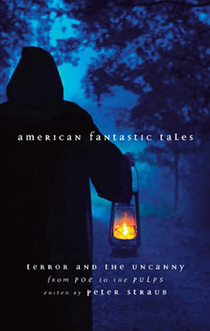From American Fantastic Tales: Terror and the Uncanny from Poe to the Pulps
Interesting Links
“F. Marion Crawford's Six Best Horror Stories” (M. Grant Kellermeyer, The Classic Horror Blog)
Biographical sketch of F. Marion Crawford (Terence E. Hanley, Tellers of Weird Tales)
Previous Story of the Week selections
• “Luella Miller,” Mary Wilkins Freeman
• “The Dead Valley,” Ralph Adams Cram
• “Kerfol,” Edith Wharton
Buy the book
 American Fantastic Tales: Terror and the Uncanny from Poe to the Pulps
American Fantastic Tales: Terror and the Uncanny from Poe to the Pulps
44 classic stories of fantasy, horror, and the supernatural | 748 pages
“F. Marion Crawford's Six Best Horror Stories” (M. Grant Kellermeyer, The Classic Horror Blog)
Biographical sketch of F. Marion Crawford (Terence E. Hanley, Tellers of Weird Tales)
Previous Story of the Week selections
• “Luella Miller,” Mary Wilkins Freeman
• “The Dead Valley,” Ralph Adams Cram
• “Kerfol,” Edith Wharton
Buy the book
 American Fantastic Tales: Terror and the Uncanny from Poe to the Pulps
American Fantastic Tales: Terror and the Uncanny from Poe to the Pulps44 classic stories of fantasy, horror, and the supernatural | 748 pages
 |
| Two drawings by American illustrator Walter Appleton Clark (1876–1906) for the original magazine publication of “For the Blood Is the Life” (Collier’s, December 16, 1905). |
The novelist Henry James was a friend of Crawford’s parents and, eventually, of the young author himself—although it might be more accurate to call them rivals, at least in James’s view. Crawford’s unbroken string of best sellers (and the financial security that came with them) was the source of considerable envy. In 1884 William Dean Howells informed James that Crawford’s third book, To Leeward, had sold nearly 10,000 copies, and James let loose with “ferocities” he acknowledged might be mistaken for “green-eyed jealousy”:
What you tell me of the success of Crawford’s last novel sickens & almost paralyses me. It seems to me (the book) so contemptibly bad & ignoble that the idea of people reading it in such numbers makes one return upon one’s self & ask what is the use of trying to write anything decent or serious for a public so absolutely idiotic. It must be totally wasted. I would rather have produced the basest experiment in the “naturalism” that is being practised here than such a piece of sixpenny humbug. Work so shamelessly bad seems to me to dishonour the novelist’s art to a degree that is absolutely not to be forgiven; just as its success dishonours the people for whom one supposes one’s self to write.Twenty years later, although the two authors had remained friends and visited each other in Italy and England, James was still harping on in private about Crawford’s fame. In a letter offering advice to a young author who admired James’s writing, he sarcastically warned against emulating his style too closely if she wanted to be popular: “I would have written, if I could, like Anthony Hope and Marion Crawford."
The approach to literature of the two rival authors could not have been more different. When the final volumes of Crawford’s Complete Works appeared, a British critic pointedly remarked on the dissimilarity: “He has no inclination, like Mr. Henry James, to analyse and dissect the complex motives of men and women in the ordinary affairs of life; his characters must be of a more or less heroic or diabolic mould, and they must live under striking and exceptional conditions.” In the book-length essay The Novel: What It Is, Crawford wrote, “There are, I believe, two recognised ways of looking at art: art for the public or ‘art for art.’” He not only argued in favor of the former but, more bluntly, he regarded the novel as a “marketable commodity, of the class collectively termed luxuries.” In Crawford’s view, the successful formula for reaching a wide readership in the late-nineteenth-century literary bazaar was a mixture of historical novels and cosmopolitan romances set in New York and Europe (especially Italy, where he was born and where he lived as an American expatriate for most of his adult life).
Yet markets are notoriously fickle. Every one of Marion Crawford’s forty-four novels has been long forgotten, while Henry James’s novels and stories are still read and admired today (and, unexpectedly, continue to be adapted for film and TV). What Crawford is remembered for would have surprised his fans and detractors alike—as well as the author himself. Two years after his death his publisher collected his various supernatural tales as Wandering Ghosts, and Crawford’s legacy rests almost entirely on those seven influential and still frequently anthologized short stories, one of which we present below as our Story of the Week selection.
Notes: The title of the story is from Deuteronomy 12:23: “Only be sure that thou eat not the blood: for the blood is the life; and thou mayest not eat the life with the flesh.”
“For the Blood Is the Life” originally appeared in the Christmas 1905 issue of Collier’s magazine. For an explanation of how ghost stories came to be associated with Christmas during the nineteenth century, see the introduction to “Thurlow’s Christmas Story,” a previous Story of the Week selection.
“For the Blood Is the Life” originally appeared in the Christmas 1905 issue of Collier’s magazine. For an explanation of how ghost stories came to be associated with Christmas during the nineteenth century, see the introduction to “Thurlow’s Christmas Story,” a previous Story of the Week selection.
* * *
We had dined at sunset on the broad roof of the old tower, because it was cooler there during the great heat of summer. . . . If you don't see the full selection below, click here (PDF) or click here (Google Docs) to read it—free!This selection may be photocopied and distributed for classroom or educational use.